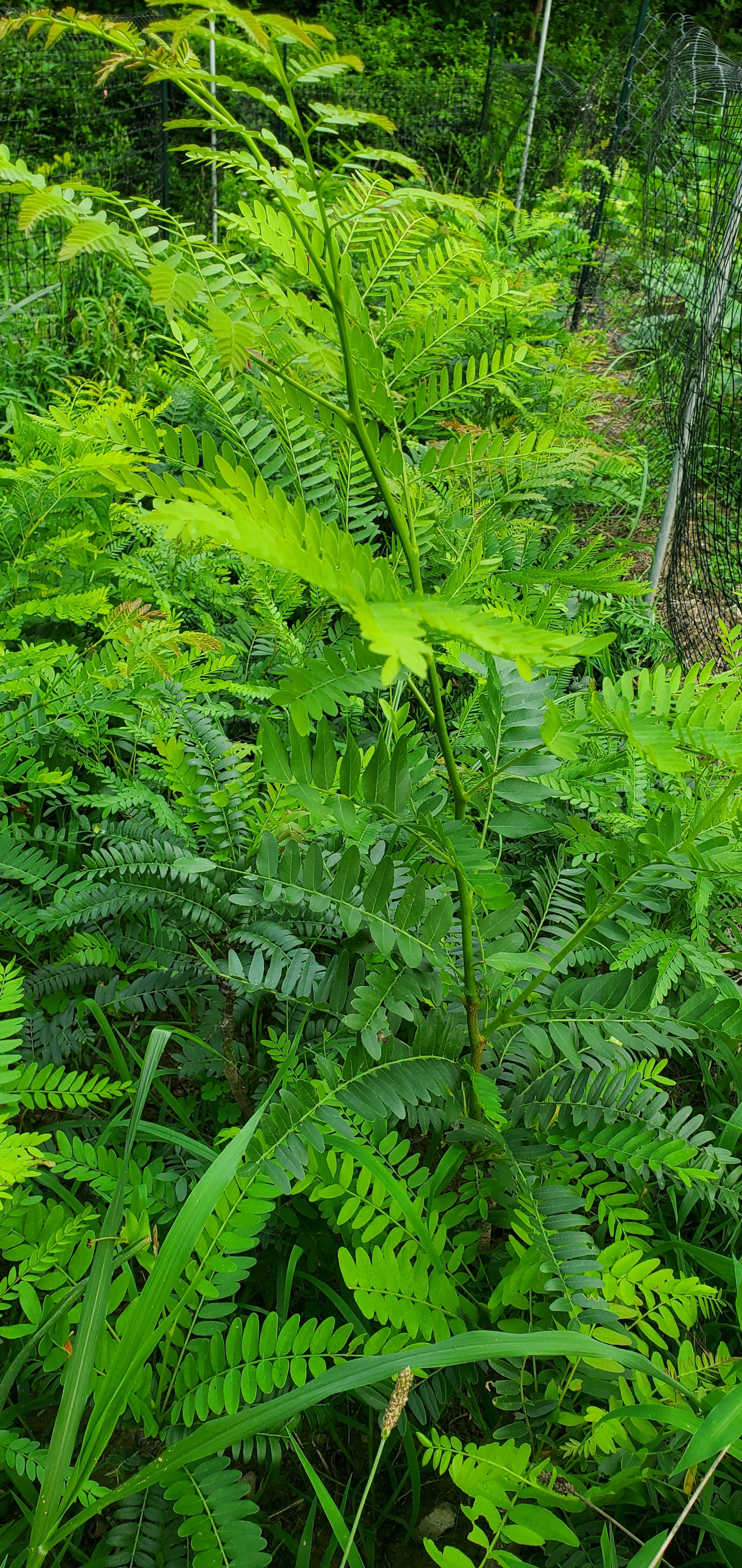 Image 1 of 6
Image 1 of 6

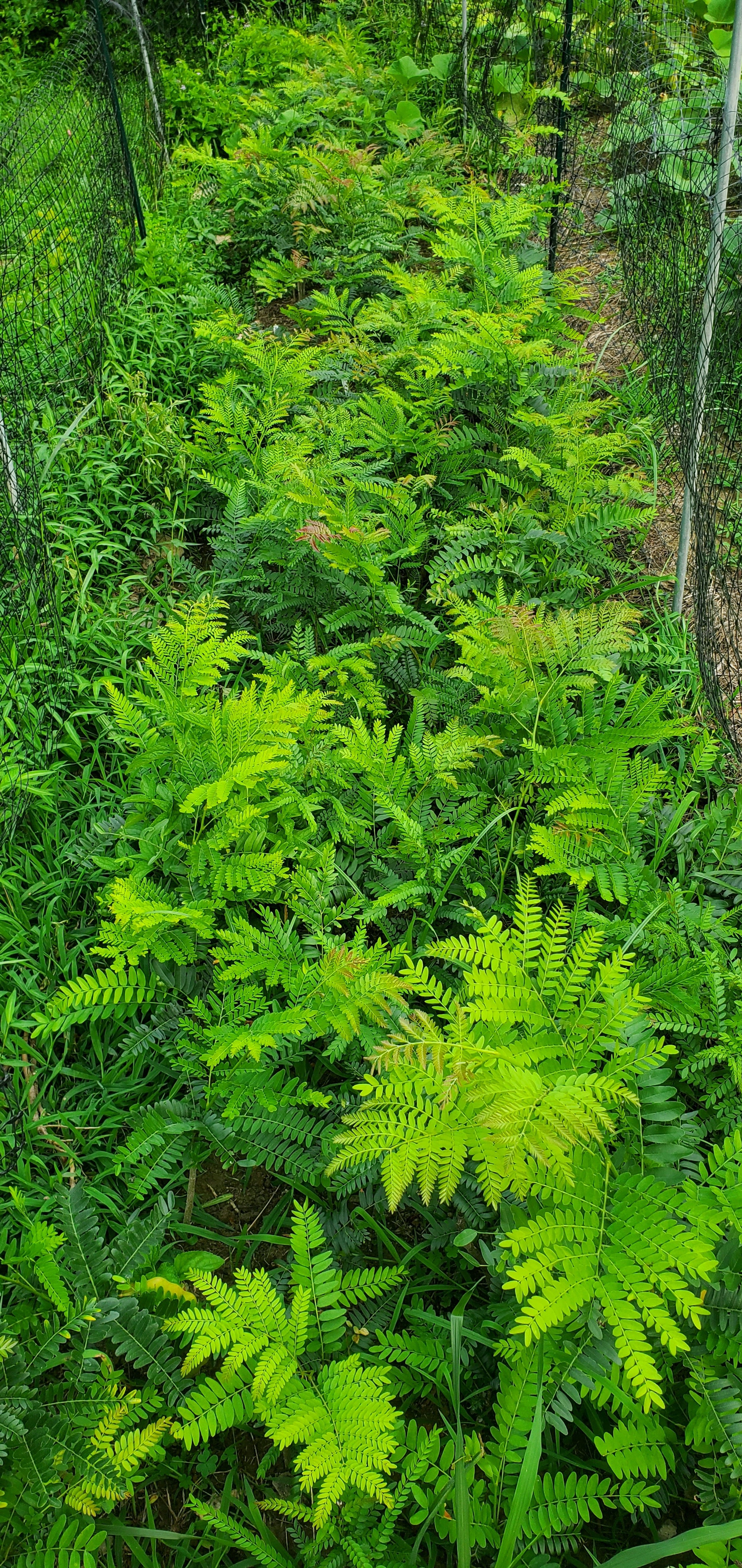 Image 2 of 6
Image 2 of 6

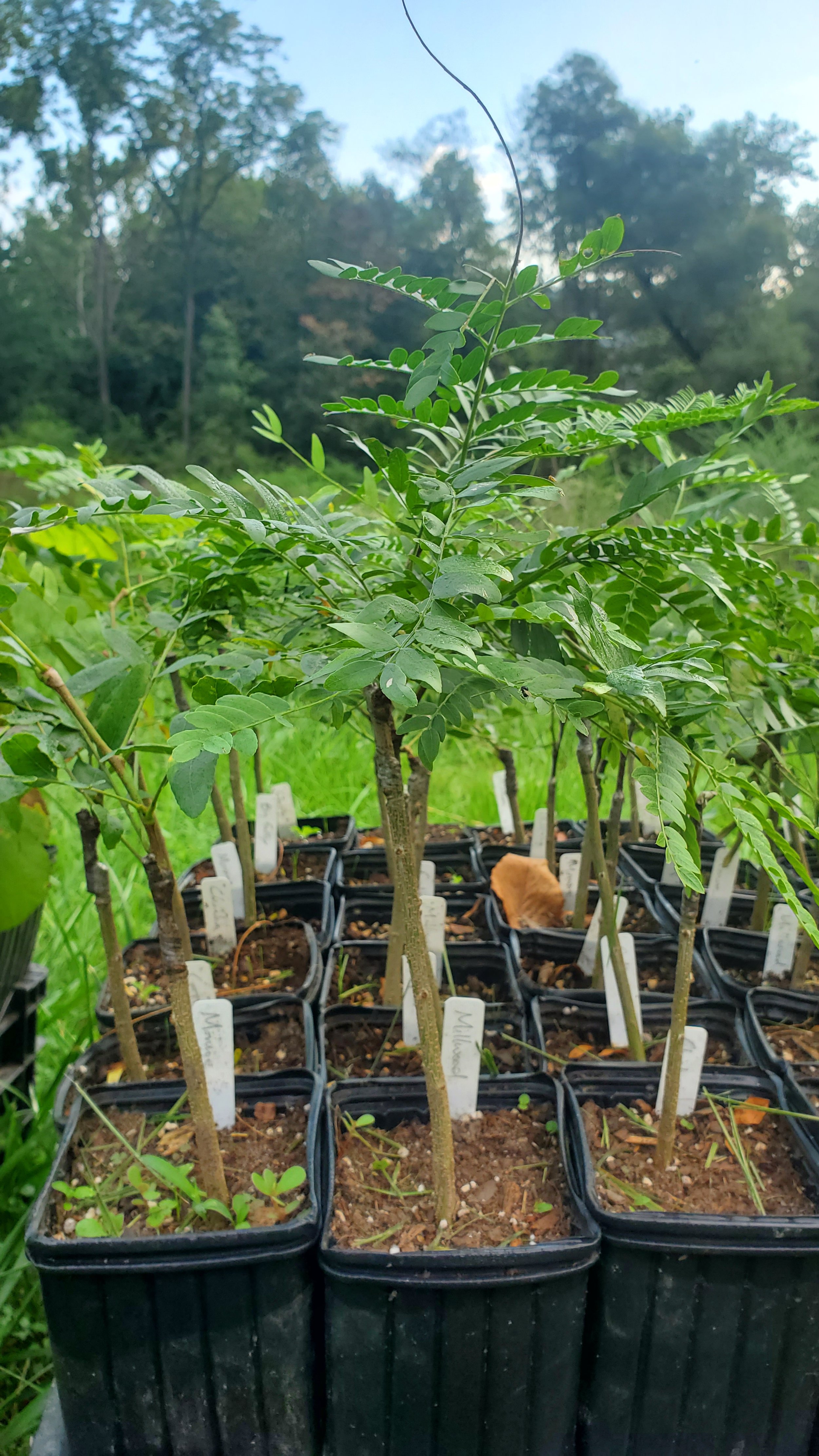 Image 3 of 6
Image 3 of 6

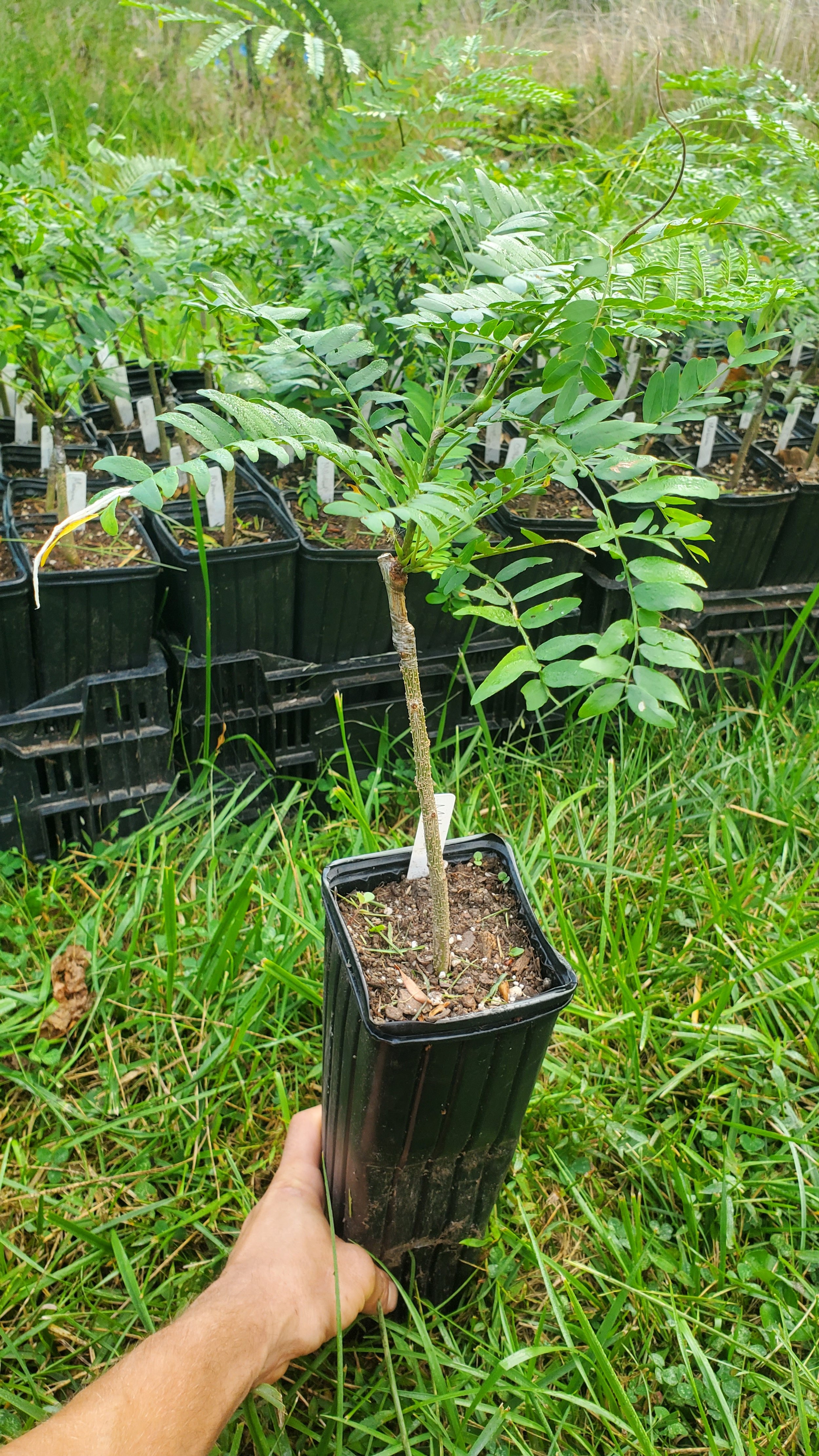 Image 4 of 6
Image 4 of 6

 Image 5 of 6
Image 5 of 6

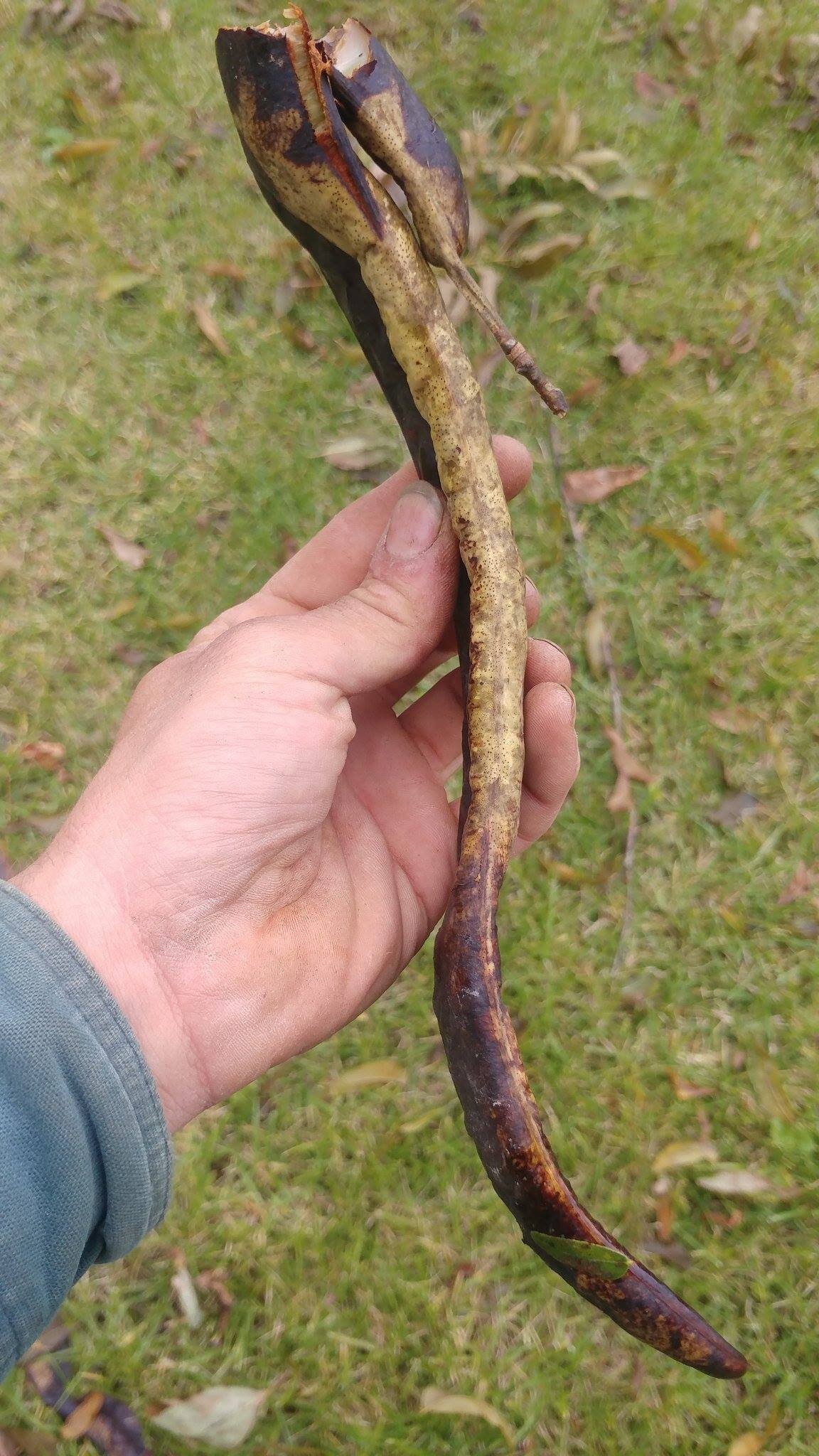 Image 6 of 6
Image 6 of 6







Grafted Honey Locust
Honey locusts are beautiful trees with patterned grey bark, slightly twisting forms, and small pinnate compound leaves casting a dappled shade. While often planted as (male) street trees, the following selections listed here are for fleshy pod production.
The inner flesh of the honey locust turns from green to an amber honey-colored sugary goo when ripe. Eaten raw, the honey locust flesh has a flavor rather like spicy apple cider, or mellower melon tones. The seeds in the pods are also a rich source of protein and have a complete amino acid profile.
Like maple sugaring in the north, Native Americans used the pods as a southern sugar tree. The pods can be dried and ground to make a carob-like powder excellent for baking. Honey locusts are desirable also for silvopastures, where during the summer months the dappled shade promotes cool season forage grasses, and in the winter the pods provide sugar and protein rich fodder.
Honey locusts are polygamodioecious and parthenocarpic, so they will produce pods even without a pollinizer. The following selections will produce separate male and female flowers on the same tree.
Grafted honey locust trees ship in 14” x 4” tree pots.
*All grafted honey locusts will grow entirely thornless, however, this does not mean the trees are genetically thornless. This matters if you need to consider the future succession of your planting, such as if into a pasture. You may want to choose genetically thornless trees to increase the odds that any feral seedlings in future years will be thornless.
Millwood – a Tennessee Valley Authority (TVA) selection first introduced by John Hershey from a tree found near Lake Junaluska, North Carolina. This variety has been extensively field tested in Virginia for silvopasture as a cattle feed. 31% sugar by weight and 13% protein. Original tree was entirely thornless.
Monroe – introduced by Alex Tanke and myself 2022. Tested at 35% sugar by weight, comparable to the best TVA selections. Seed source from Monroe County Arkansas and the original tree is entirely thornless. Performs well in zones 5b/6a! Good for more northern plantings.
Calhoun – introduced through John Hershey's work at the TVA. Pods 38% sugar by weight. Tree bears most years, semi-annually. Zone 6b and warmer.
Big Fatty – selection from the remains of John Hershey's farm. Believed to be a seedling from his breeding but it is probable that it is actually just Calhoun. Pods test at 38-41% sugar by weight. Tree is annually bearing, although as production is spread out each year the volume is lower than production from biennially-bearing trees. Recommended zone 6 and warmer.
Chiaha – my 2023 selection from Tennessee. Named for the Native village of the Koasati and later Cherokee which once stood where this tree was found. The pods are among the fleshiest I've seen - though test results await. Original tree is moderately thorny but grafts will be thornless.
Cooper – fleshy podded selection from Taylor Malone in Tennessee. Original tree was nearly thornless.
Ashworth – a northern selection by Bill MacKentley and Fred L. Ashworth of St. Lawrence Nursery, Potsdam, NY, circa mid-1970s. Very sweet pods said to taste like melon, but not as fleshy as TVA selections Millwood and Calhoun. Original tree from New York state in zone 3b/4a, so this is good for northern plantings colder than zone 6.
Hershey – from the breeding work of John Hershey, and named after him. 16 pods to the pound. Heavy bearer.
Schofer – named for Richard Schofer, who found the original tree near Pennsburg, PA. Schofer operated a bakery in Reading, PA where he had a honey locust orchard he planted to supply the bakery. John Hershey and J. Russell Smith introduced Schofer into their later catalogs, describing it as a fleshy honey locust which solved the hardiness problem for the north.
Marguerite – This variety introduced by Hector Black of Hidden Springs Nursery in TN. A solid, fleshy-podded variety.
Colley – selection from Hopkinsville, KY by myself and Lucky Pittman. Original tree is entirely thornless and remains of pods on ground looked promising. Remains to be tested.
Piatt – another selection from Alex Tanke and myself. This fleshy podded variety comes originally from Piatt county, Illinois and is tested for zone 6a, so can be recommended for the north.
Poole Forge – an Austin Unruh of Trees for Graziers selection from Narvon, PA. Original tree is entirely thornless and tested at 28% sugar.
Richland – promising fleshy-podded selection from Tennessee. Original tree moderately thorny.
Trotter Experimental Series – untested selections from Tennessee which I made in the field in 2023 based upon pod fleshiness. Ortet trees labeled as thornless or thorny for breeding purposes, but all grafts will grow thornless.
Honey locusts are beautiful trees with patterned grey bark, slightly twisting forms, and small pinnate compound leaves casting a dappled shade. While often planted as (male) street trees, the following selections listed here are for fleshy pod production.
The inner flesh of the honey locust turns from green to an amber honey-colored sugary goo when ripe. Eaten raw, the honey locust flesh has a flavor rather like spicy apple cider, or mellower melon tones. The seeds in the pods are also a rich source of protein and have a complete amino acid profile.
Like maple sugaring in the north, Native Americans used the pods as a southern sugar tree. The pods can be dried and ground to make a carob-like powder excellent for baking. Honey locusts are desirable also for silvopastures, where during the summer months the dappled shade promotes cool season forage grasses, and in the winter the pods provide sugar and protein rich fodder.
Honey locusts are polygamodioecious and parthenocarpic, so they will produce pods even without a pollinizer. The following selections will produce separate male and female flowers on the same tree.
Grafted honey locust trees ship in 14” x 4” tree pots.
*All grafted honey locusts will grow entirely thornless, however, this does not mean the trees are genetically thornless. This matters if you need to consider the future succession of your planting, such as if into a pasture. You may want to choose genetically thornless trees to increase the odds that any feral seedlings in future years will be thornless.
Millwood – a Tennessee Valley Authority (TVA) selection first introduced by John Hershey from a tree found near Lake Junaluska, North Carolina. This variety has been extensively field tested in Virginia for silvopasture as a cattle feed. 31% sugar by weight and 13% protein. Original tree was entirely thornless.
Monroe – introduced by Alex Tanke and myself 2022. Tested at 35% sugar by weight, comparable to the best TVA selections. Seed source from Monroe County Arkansas and the original tree is entirely thornless. Performs well in zones 5b/6a! Good for more northern plantings.
Calhoun – introduced through John Hershey's work at the TVA. Pods 38% sugar by weight. Tree bears most years, semi-annually. Zone 6b and warmer.
Big Fatty – selection from the remains of John Hershey's farm. Believed to be a seedling from his breeding but it is probable that it is actually just Calhoun. Pods test at 38-41% sugar by weight. Tree is annually bearing, although as production is spread out each year the volume is lower than production from biennially-bearing trees. Recommended zone 6 and warmer.
Chiaha – my 2023 selection from Tennessee. Named for the Native village of the Koasati and later Cherokee which once stood where this tree was found. The pods are among the fleshiest I've seen - though test results await. Original tree is moderately thorny but grafts will be thornless.
Cooper – fleshy podded selection from Taylor Malone in Tennessee. Original tree was nearly thornless.
Ashworth – a northern selection by Bill MacKentley and Fred L. Ashworth of St. Lawrence Nursery, Potsdam, NY, circa mid-1970s. Very sweet pods said to taste like melon, but not as fleshy as TVA selections Millwood and Calhoun. Original tree from New York state in zone 3b/4a, so this is good for northern plantings colder than zone 6.
Hershey – from the breeding work of John Hershey, and named after him. 16 pods to the pound. Heavy bearer.
Schofer – named for Richard Schofer, who found the original tree near Pennsburg, PA. Schofer operated a bakery in Reading, PA where he had a honey locust orchard he planted to supply the bakery. John Hershey and J. Russell Smith introduced Schofer into their later catalogs, describing it as a fleshy honey locust which solved the hardiness problem for the north.
Marguerite – This variety introduced by Hector Black of Hidden Springs Nursery in TN. A solid, fleshy-podded variety.
Colley – selection from Hopkinsville, KY by myself and Lucky Pittman. Original tree is entirely thornless and remains of pods on ground looked promising. Remains to be tested.
Piatt – another selection from Alex Tanke and myself. This fleshy podded variety comes originally from Piatt county, Illinois and is tested for zone 6a, so can be recommended for the north.
Poole Forge – an Austin Unruh of Trees for Graziers selection from Narvon, PA. Original tree is entirely thornless and tested at 28% sugar.
Richland – promising fleshy-podded selection from Tennessee. Original tree moderately thorny.
Trotter Experimental Series – untested selections from Tennessee which I made in the field in 2023 based upon pod fleshiness. Ortet trees labeled as thornless or thorny for breeding purposes, but all grafts will grow thornless.
Honey locusts are beautiful trees with patterned grey bark, slightly twisting forms, and small pinnate compound leaves casting a dappled shade. While often planted as (male) street trees, the following selections listed here are for fleshy pod production.
The inner flesh of the honey locust turns from green to an amber honey-colored sugary goo when ripe. Eaten raw, the honey locust flesh has a flavor rather like spicy apple cider, or mellower melon tones. The seeds in the pods are also a rich source of protein and have a complete amino acid profile.
Like maple sugaring in the north, Native Americans used the pods as a southern sugar tree. The pods can be dried and ground to make a carob-like powder excellent for baking. Honey locusts are desirable also for silvopastures, where during the summer months the dappled shade promotes cool season forage grasses, and in the winter the pods provide sugar and protein rich fodder.
Honey locusts are polygamodioecious and parthenocarpic, so they will produce pods even without a pollinizer. The following selections will produce separate male and female flowers on the same tree.
Grafted honey locust trees ship in 14” x 4” tree pots.
*All grafted honey locusts will grow entirely thornless, however, this does not mean the trees are genetically thornless. This matters if you need to consider the future succession of your planting, such as if into a pasture. You may want to choose genetically thornless trees to increase the odds that any feral seedlings in future years will be thornless.
Millwood – a Tennessee Valley Authority (TVA) selection first introduced by John Hershey from a tree found near Lake Junaluska, North Carolina. This variety has been extensively field tested in Virginia for silvopasture as a cattle feed. 31% sugar by weight and 13% protein. Original tree was entirely thornless.
Monroe – introduced by Alex Tanke and myself 2022. Tested at 35% sugar by weight, comparable to the best TVA selections. Seed source from Monroe County Arkansas and the original tree is entirely thornless. Performs well in zones 5b/6a! Good for more northern plantings.
Calhoun – introduced through John Hershey's work at the TVA. Pods 38% sugar by weight. Tree bears most years, semi-annually. Zone 6b and warmer.
Big Fatty – selection from the remains of John Hershey's farm. Believed to be a seedling from his breeding but it is probable that it is actually just Calhoun. Pods test at 38-41% sugar by weight. Tree is annually bearing, although as production is spread out each year the volume is lower than production from biennially-bearing trees. Recommended zone 6 and warmer.
Chiaha – my 2023 selection from Tennessee. Named for the Native village of the Koasati and later Cherokee which once stood where this tree was found. The pods are among the fleshiest I've seen - though test results await. Original tree is moderately thorny but grafts will be thornless.
Cooper – fleshy podded selection from Taylor Malone in Tennessee. Original tree was nearly thornless.
Ashworth – a northern selection by Bill MacKentley and Fred L. Ashworth of St. Lawrence Nursery, Potsdam, NY, circa mid-1970s. Very sweet pods said to taste like melon, but not as fleshy as TVA selections Millwood and Calhoun. Original tree from New York state in zone 3b/4a, so this is good for northern plantings colder than zone 6.
Hershey – from the breeding work of John Hershey, and named after him. 16 pods to the pound. Heavy bearer.
Schofer – named for Richard Schofer, who found the original tree near Pennsburg, PA. Schofer operated a bakery in Reading, PA where he had a honey locust orchard he planted to supply the bakery. John Hershey and J. Russell Smith introduced Schofer into their later catalogs, describing it as a fleshy honey locust which solved the hardiness problem for the north.
Marguerite – This variety introduced by Hector Black of Hidden Springs Nursery in TN. A solid, fleshy-podded variety.
Colley – selection from Hopkinsville, KY by myself and Lucky Pittman. Original tree is entirely thornless and remains of pods on ground looked promising. Remains to be tested.
Piatt – another selection from Alex Tanke and myself. This fleshy podded variety comes originally from Piatt county, Illinois and is tested for zone 6a, so can be recommended for the north.
Poole Forge – an Austin Unruh of Trees for Graziers selection from Narvon, PA. Original tree is entirely thornless and tested at 28% sugar.
Richland – promising fleshy-podded selection from Tennessee. Original tree moderately thorny.
Trotter Experimental Series – untested selections from Tennessee which I made in the field in 2023 based upon pod fleshiness. Ortet trees labeled as thornless or thorny for breeding purposes, but all grafts will grow thornless.